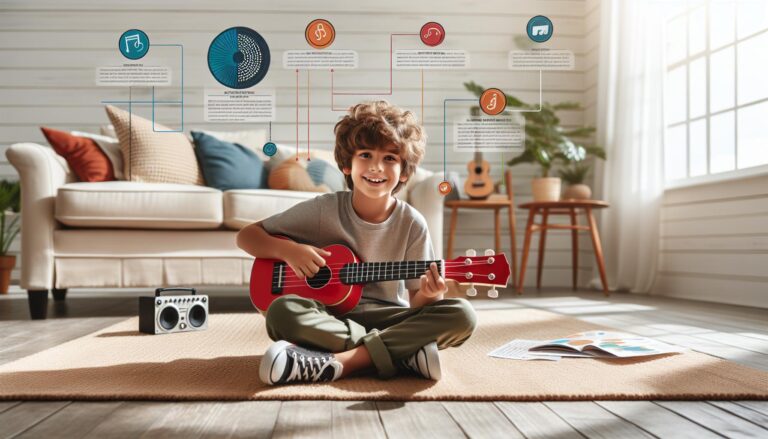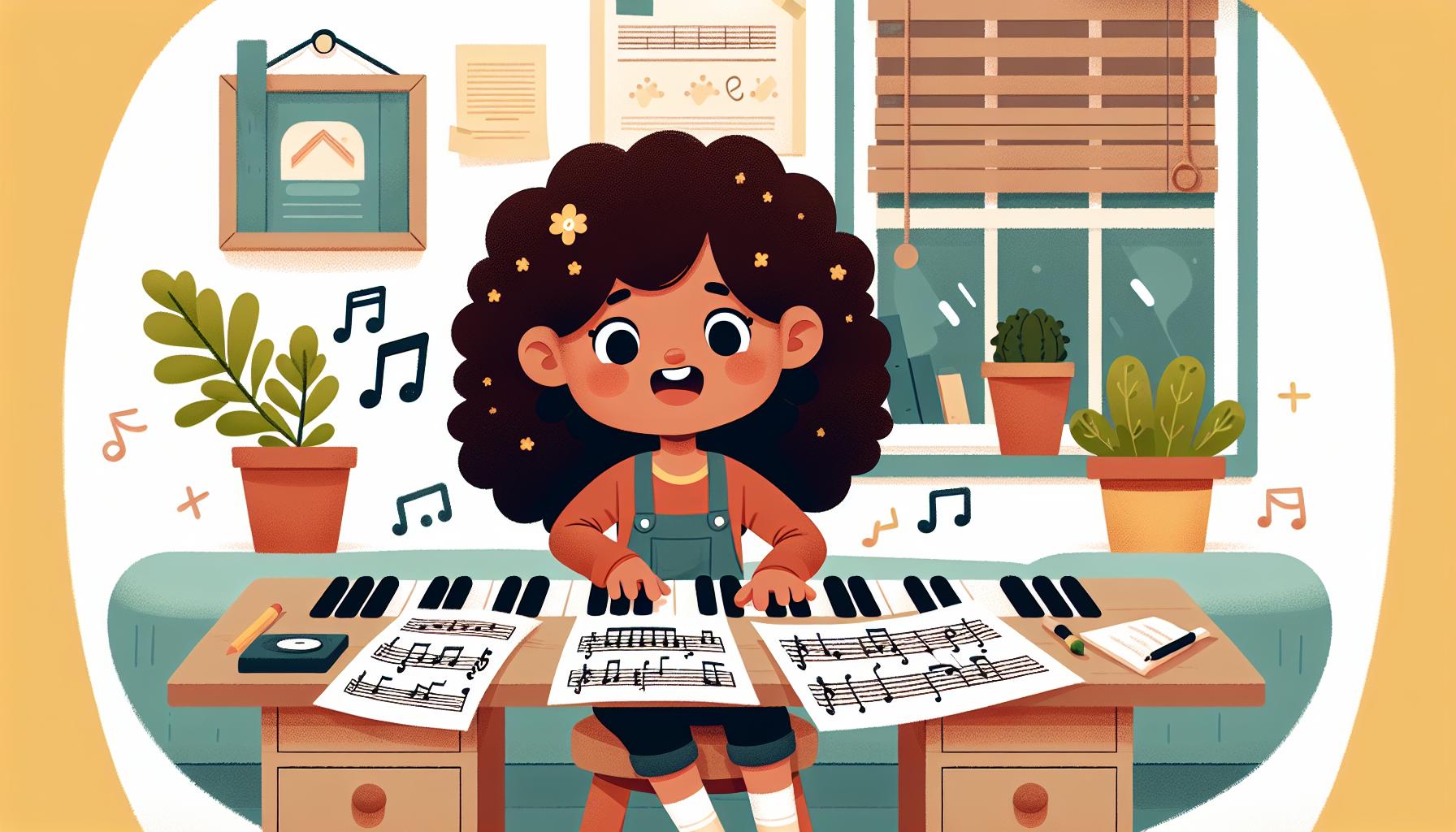
Key Takeaways
- Homeschooling music lessons provide flexibility, allowing families to tailor schedules and create a personalized learning pace for their children.
- Building a supportive environment fosters creativity, strengthens the parent-child bond, and encourages musical growth.
- Choosing the right curriculum and incorporating your child’s musical interests keep lessons engaging and enjoyable.
- Essential tools like age-appropriate instruments, online platforms, and educational books enhance the homeschooling music experience.
- Overcoming challenges, such as maintaining motivation and accessing professional guidance when needed, ensures consistent progress.
- Tracking progress, celebrating achievements, and encouraging creativity help children stay inspired and confident in their musical journey.
Teaching music at home can feel like a big task, but it’s also an incredibly rewarding journey. Whether we’re exploring piano keys or strumming a guitar, music offers our children a creative outlet and valuable skills. But how do we make music lessons engaging and effective without a traditional classroom setting?
We all want our kids to thrive, but finding the right approach for homeschooling music can raise plenty of questions. Should we follow a structured curriculum? How do we keep lessons fun and inspiring? The good news is, with the right tools and mindset, music education at home can be both enjoyable and impactful for the whole family.
Let’s dive into how we can create a supportive environment for learning music and discover strategies to help our kids connect with their inner musician.
Benefits Of Homeschooling Music Lessons
Homeschooling music lessons offer several advantages for children and parents. These benefits create a nurturing environment that supports creativity and skill development.
Flexibility In Scheduling
Homeschooling allows us to plan lessons around our daily routines. We can choose the best times for learning, ensuring children are attentive and engaged. Unlike traditional settings with fixed timings, this flexibility lets us balance music practice with other activities like academics or family commitments. Have you considered how this approach could reduce stress for kids and parents alike?
Personalized Learning Pace
Each child learns differently, and homeschooling enables us to adapt lessons to their needs. Whether progressing quickly through concepts or spending extra time on challenging areas, children have a chance to fully master skills. By focusing on strengths and addressing gaps, we can create a more effective learning experience. How could a customized pace benefit your child’s confidence in mastering music?
Strengthening Parent-Child Bond
Teaching music at home strengthens the connection between us and our children. Sharing the learning journey builds communication, patience, and trust. We experience their progress firsthand and celebrate their achievements together. Could this shared experience deepen your relationship with your child through mutual growth and support?
Choosing The Right Curriculum For Homeschool Music Lessons

Selecting the right curriculum can be crucial in fostering a productive and enjoyable music-learning experience at home. With so many options available, it’s important to pick one that resonates with your child’s learning needs and goals.
Exploring Available Resources
There are various resources to consider when choosing a homeschool music curriculum. Online platforms often provide structured courses with video tutorials and printable materials. Workbooks and sheet music collections from educational publishers can offer step-by-step guidance for mastering instruments or music theory. Community libraries might also have books and media that cover a range of musical topics.
For those looking for a more interactive option, live virtual lessons connect students with experienced instructors who provide real-time guidance. Additionally, local music teachers may offer custom lesson plans that integrate seamlessly into homeschool schedules. Which resources best align with your child’s learning style?
Tailoring Lessons To Your Child’s Interests
Incorporating your child’s preferences into their music education helps maintain their engagement. If your child enjoys specific genres, such as classical or pop, incorporating these styles into their lessons can inspire enthusiasm. Likewise, introducing songs by their favorite artists often adds a personal connection to the learning process.
Recognizing their preferred learning pace also matters. Some children thrive with structured, detailed lessons, while others excel with creative, exploratory approaches. Understanding what excites and motivates them creates a foundation for a more fulfilling music journey. How can you adapt lessons to fuel their curiosity and creativity?
Tools And Resources For Homeschooling Music Lessons

Setting up effective music lessons at home starts with the right tools. Resources like instruments, online platforms, and educational books make the process smoother and more engaging. What materials align best with your child’s learning style?
Instruments And Equipment
Using proper instruments is key to successful music lessons. Choose instruments suited to your child’s age, size, and musical interests. For beginners, consider entry-level options like keyboards, acoustic guitars, or recorders. Don’t forget accessories like tuners, metronomes, and music stands. These tools support skill growth and encourage consistent practice.
For at-home learners, digital instruments like electric pianos with headphone jacks can reduce noise concerns. If space is limited, portable items like ukuleles or compact percussion sets offer flexibility without hindering creativity. Having instruments readily available can inspire impromptu practice sessions, enhancing skill retention.
Online Platforms And Apps
Digital tools expand learning possibilities for homeschooling music lessons. Interactive platforms offer video tutorials, practice exercises, and performance feedback. Many apps focus on building specific skills, including sight-reading, ear training, and rhythm accuracy. These tools allow children to explore music independently or supplement live instruction.
Exploring platforms that fit your child’s learning pace fosters motivation and focus. For instance, some apps gamify lessons, turning practice into a fun challenge. Seeking resources with adjustable difficulty levels ensures long-term usability and gradual progress. Which features might simplify your child’s music education journey?
Books And Workbooks
Physical workbooks provide structure and clarity. Select books appropriate for your child’s skill level and interests. Lesson books often include detailed explanations, sheet music, and exercises. Pair these with fun activity books to make learning enjoyable and less intimidating.
Look for materials covering music theory, techniques, and history. Incorporating books about composers or styles related to your child’s favorite genres nurtures curiosity. Do these resources match their enthusiasm while gently introducing new concepts? Aim for options that balance education with enjoyment.
Overcoming Challenges In Homeschool Music Education
Teaching music at home brings both opportunities and obstacles. Identifying and addressing these challenges early can help create an effective and enjoyable learning experience.
Maintaining Motivation And Consistency
Maintaining a steady interest in music can be challenging for children over time. Incorporating variety in activities helps combat monotony. For example, alternating between instrument practice, music theory, and creative exercises like composition keeps lessons engaging.
Tracking progress can build a sense of accomplishment. Recording practice sessions or setting tangible goals, like learning a new song, offers measurable progress children can celebrate. How do we keep children excited about their achievements? By celebrating milestones through small rewards or sharing their progress with family.
Establishing a routine also fosters consistency. Choose a regular time and keep lesson durations appropriate to the child’s age and attention span. If interest wanes, refreshing the materials or adjusting the pace allows children to regain enthusiasm.
Accessing Professional Instruction When Needed
We might encounter topics or techniques beyond our expertise. Seeking a professional instructor for occasional guidance can enhance skill development. Many online platforms and local music teachers offer one-on-one lessons, which can address specific challenges children face.
Supplementing with pre-recorded tutorials or live virtual classes enriches the learning experience. These resources often introduce advanced concepts like improvisation or sight-reading in ways we might not replicate. Have you explored specialized resources to introduce these skills?
Collaborating with professionals doesn’t diminish our role. Instead, it strengthens the foundation we build at home while exposing children to new perspectives. Balancing home instruction with expert insights provides well-rounded musical growth.
Tips For Success In Homeschooling Music Lessons
Creating a positive and productive learning experience for homeschooling music lessons requires thoughtful planning and engagement. These tips help parents foster a conducive environment for musical growth and enjoyment.
Establishing A Regular Routine
Consistency in scheduling lessons helps develop habits that encourage progress. Set aside specific days and times for music practice and lessons to create a rhythm within the child’s weekly schedule. This predictability reduces distractions and helps children focus on their learning. How can your family create a routine that fits your daily life without feeling overwhelming?
Incorporate warm-up exercises into the start of each session, such as scales or breathing techniques for singers. Designate breaks during longer practices to maintain energy and focus. Adjustments to the routine might be necessary to match your child’s attention span, especially when introducing new concepts.
Encouraging Creativity And Fun
Fostering a sense of enjoyment sparks motivation in children. Make lessons engaging by involving their favorite songs, genres, or artists. How does your child’s musical taste influence their learning style? Let their preferences inspire the structure of lessons to maintain enthusiasm.
Incorporate interactive activities like rhythm games, improvisation, or composing short pieces. Use everyday objects as percussive instruments or create songs together to nurture a playful approach. Offer opportunities for experimenting with sounds, which can broaden musical understanding and deepen interest.
Tracking Progress And Celebrating Milestones
Monitor achievements to recognize growth and maintain momentum. Keep a simple practice diary noting completed exercises, mastered skills, or learned pieces. Video or audio recordings serve as a reference to see how far your child has advanced over time.
Celebrate small and large milestones alike, from learning their first song to mastering a technique. Rewards can be as simple as words of praise, stickers, or an informal recital for family. How might celebrating success boost your child’s confidence and love for music? Encourage them to take pride in reaching their musical goals.
Conclusion
Homeschooling music lessons offer a unique opportunity to nurture creativity, build valuable skills, and strengthen the bond we share with our children. By tailoring lessons to their interests and learning pace, we can create a supportive environment that fosters growth and enjoyment.
With the right tools, resources, and a touch of professional guidance when needed, we can overcome challenges and keep the learning process engaging. Through consistency, celebration of milestones, and a focus on their passions, we can inspire a lifelong love for music in our children.
Frequently Asked Questions
1. What are the benefits of teaching music at home?
Teaching music at home offers flexibility in scheduling, allows for a personalized learning pace, and strengthens the parent-child bond. It encourages creativity, helps children master skills effectively, and provides a stress-free environment for learning music.
2. Do I need a structured curriculum for homeschool music lessons?
A structured curriculum isn’t mandatory but can be helpful. Choose one that matches your child’s learning style, goals, and interests. Incorporating variety, such as favorite songs or genres, can keep lessons engaging and effective.
3. What tools do I need for home music lessons?
Begin with age-appropriate instruments, digital tools like apps, and physical workbooks that cover theory and history. Ensure resources align with your child’s learning preferences to create a productive and enjoyable experience.
4. How can I keep my child motivated to learn music at home?
Incorporate variety in lessons, practice routines, and celebrate milestones. Using favorite songs, interactive activities, and tracking progress can boost engagement and confidence while maintaining motivation.
5. Should I seek professional help for homeschool music lessons?
Yes, occasional guidance from instructors or online resources can enrich learning. Professionals can provide expert tips, address challenges, and enhance skill development while complementing the parent-led learning process.
6. How do I choose the right instrument for my child?
Pick an instrument suited to your child’s age, size, and musical interests. For beginners, start with entry-level instruments that are easier to play and build confidence.
7. What strategies can I use to make music lessons more engaging?
Incorporate your child’s favorite songs, use interactive apps, and include creative activities like composing simple tunes. Creating an enjoyable and dynamic learning environment is key to keeping children interested.
8. How do I balance music lessons with my family’s routine?
Homeschool music allows for a flexible schedule. Plan lessons at times that suit your family’s daily activities, ensuring consistency while avoiding overwhelming your child or yourself.
9. How do I track my child’s progress in music?
Keep a record of completed lessons, skills mastered, and milestones achieved. Celebrate accomplishments to boost confidence and maintain motivation for further learning.
10. What are some challenges of teaching music at home, and how do I overcome them?
Challenges include maintaining consistency and motivation. Overcome these by establishing routines, incorporating varied activities, and seeking occasional help from professionals to provide fresh perspectives.

